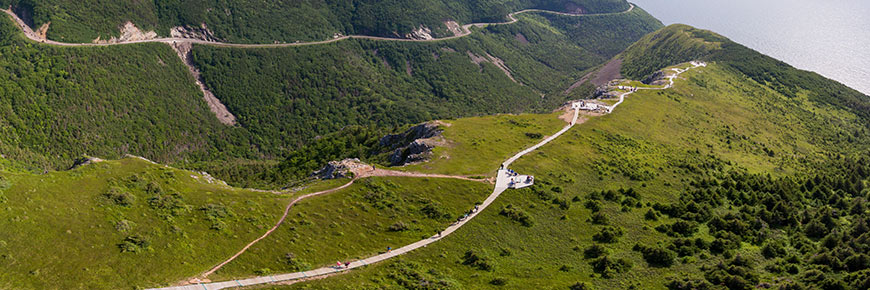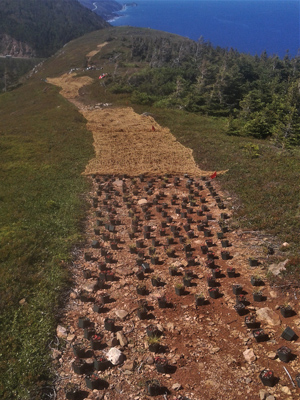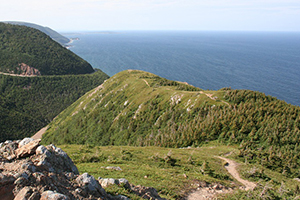
Restoration work on Skyline trail
Cape Breton Highlands National Park
The Skyline trail is Cape Breton Highlands National Park’s most popular trail and has earned a reputation for its spectacular views. As one of Nova Scotia's iconic experiences, it welcomes over 50,000 visitors each year.
Unfortunately, its popularity has caused significant damage to the ecosystem. With large numbers of visitors flocking to the Skyline trail, a boardwalk was built in the 1990s as a way of protecting this important ecosystem. However, visitors have been walking off the boardwalk over the years and onto the fragile headland, which is presenting considerable environmental as well as safety concerns.
Parks Canada is all about preserving and protecting nationally significant examples of Canada’s natural and cultural heritage. This is why we are taking action to restore the headland at the tip of the Skyline trail.
What makes this area special?

Restoration work has started
The type of headland barren on the Skyline trail is not very common in Nova Scotia. The plants that live in these barrens exist because the microclimate extremes make the place inhospitable to trees. This vegetation is only found in a few locations within Cape Breton Highlands National Park as well as north of the park. This vegetation has an important role to play in nature; it's part of the habitat for bees and other species such as berries, and is not resistant to foot traffic. The shrubs are hardy but they can’t survive repeated trampling.
What action is being taken?
Parks Canada is working with Saint Mary's University to rehabilitate the degraded vegetation on the Skyline headland, to restore this important ecosystem and to raise awareness of the issue by reminding visitors to respect nature while enjoying spectacular views.
There are two areas of concern where visitors have ventured off the boardwalk and created "unofficial" trails that have damaged the rare vegetation found in the area. The degradation covers about 500 m2 and includes soil erosion and compaction, loss of soil organic matter, loss of soil microbe communities and soil nutrients, loss of native seed banks, and increased habitat for invasive species.
Four different treatments are being tested to see what works best to reverse this damage. To help with these treatments, more than 485 bags of topsoil were hauled to the end of the Skyline trail. Some of these treatments also include matting for protection. Once the shrub mat is broken due to walking off the boardwalk, it further delays the recovery period. Monitoring is also an important component of this restoration project and will continue over next 5 to 10 years to determine which method is most effective in the long run.
Safety first!
Along with the damage to the fragile heathland, these "unofficial" trails have also created a safety issue. The Skyline boardwalk was built to protect the vegetation but also for safety reasons. Over the years, visitors have ventured off the Skyline boardwalk and have put their safety at risk by going too close to the side of the cliffs. A fall from those cliffs would cause serious injury and would put first responders at risk.
Venturing off the boardwalk can also lead to human wildlife conflicts since the narrowness of that headland with only one escape point makes it more hazardous should visitors encounter a moose or a bear. Limiting foot traffic to the boardwalk is the safest option to take in the spectacular views.
It’s really about enjoying nature’s beauty, reducing our environmental footprint, and taking in spectacular views responsibly for generations to enjoy.
What can visitors do?
Visitors visiting the Skyline trail are asked to stay on the boardwalk at all times. Although it may be tempting to follow trails leading off the boardwalk, visitors are reminded to not follow them, no matter how enticing they may seem. The areas they lead to are not safe for visitors, and walking on these unofficial trails damage the plant life growing on or near them. We all like to blaze our own trail, but for the sake of the environment, your enjoyment, and others’ enjoyment, please stick to the boardwalk.
Lastly, we could use your help. Help us spread the word and protect this important landscape and spectacular view.

Today's view

Tomorrow's view
Interested in knowing more about this restoration project?
Contact us at cbinfo@pc.gc.ca or call 902-285-3000
- Date modified :